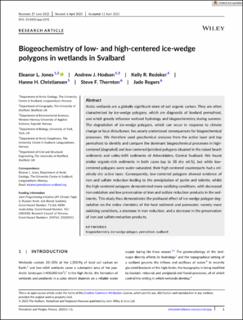| dc.contributor.author | Jones, Eleanor L. | |
| dc.contributor.author | Hodson, Andrew | |
| dc.contributor.author | Redeker, Kelly Robert | |
| dc.contributor.author | Christiansen, Hanne H. | |
| dc.contributor.author | Thornton, Steve F. | |
| dc.contributor.author | Rogers, Jade | |
| dc.date.accessioned | 2023-06-19T06:05:51Z | |
| dc.date.available | 2023-06-19T06:05:51Z | |
| dc.date.created | 2023-05-09T14:04:46Z | |
| dc.date.issued | 2023 | |
| dc.identifier.issn | 1045-6740 | |
| dc.identifier.uri | https://hdl.handle.net/11250/3071940 | |
| dc.description.abstract | Arctic wetlands are a globally significant store of soil organic carbon. They are often characterized by ice-wedge polygons, which are diagnostic of lowland permafrost, and which greatly influence wetland hydrology and biogeochemistry during summer. The degradation of ice-wedge polygons, which can occur in response to climate change or local disturbance, has poorly understood consequences for biogeochemical processes. We therefore used geochemical analyses from the active layer and top permafrost to identify and compare the dominant biogeochemical processes in high-centered (degraded) and low-centered (pristine) polygons situated in the raised beach sediments and valley-infill sediments of Adventdalen, Central Svalbard. We found similar organic-rich sediments in both cases (up to 38 dry wt.%), but while low-centered polygons were water-saturated, their high-centered counterparts had a relatively dry active layer. Consequently, low-centered polygons showed evidence of iron and sulfate reduction leading to the precipitation of pyrite and siderite, whilst the high-centered polygons demonstrated more oxidizing conditions, with decreased iron oxidation and low preservation of iron and sulfate reduction products in the sediments. This study thus demonstrates the profound effect of ice-wedge polygon degradation on the redox chemistry of the host sediment and porewater, namely more oxidizing conditions, a decrease in iron reduction, and a decrease in the preservation of iron and sulfate reduction products. | en_US |
| dc.language.iso | eng | en_US |
| dc.publisher | Wiley | en_US |
| dc.rights | Navngivelse 4.0 Internasjonal | * |
| dc.rights.uri | http://creativecommons.org/licenses/by/4.0/deed.no | * |
| dc.title | Biogeochemistry of low- and high-centered ice-wedge polygons in wetlands in Svalbard | en_US |
| dc.title.alternative | Biogeochemistry of low- and high-centered ice-wedge polygons in wetlands in Svalbard | en_US |
| dc.type | Peer reviewed | en_US |
| dc.type | Journal article | en_US |
| dc.description.version | publishedVersion | en_US |
| dc.rights.holder | © 2023 The Authors | en_US |
| dc.source.journal | Permafrost and Periglacial Processes | en_US |
| dc.identifier.doi | 10.1002/ppp.2192 | |
| dc.identifier.cristin | 2146470 | |
| dc.relation.project | EU/JPI Topic 2 (Project 71126) | en_US |
| dc.relation.project | Norges forskningsråd: 244906 | en_US |
| dc.relation.project | Norges forskningsråd: 294764 | en_US |
| cristin.ispublished | true | |
| cristin.fulltext | original | |
| cristin.qualitycode | 1 | |

